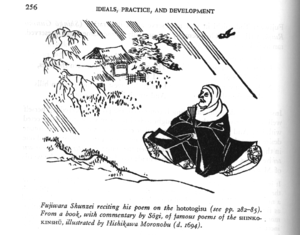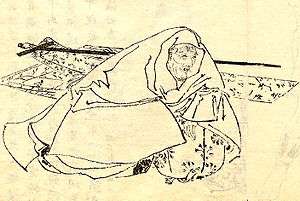Fujiwara no Shunzei

Fujiwara no Shunzei (藤原 俊成, 1114 - December 22, 1204) was a noted Japanese poet and nobleman, son of Fujiwara no Toshitada. He was also known as Fujiwara no Toshinari[1] or Shakua (釈阿); in his younger days (1123–67), he gave his name as Akihiro (顕広), but in 1167, changed to Shunzei. He was noted for his innovations in the waka poetic form, and for his achievement in compiling Senzai Wakashū ("Collection of a Thousand Years"), the seventh Imperial anthology of waka poetry; this work was at the behest in 1183 of the Retired Emperor Go-Shirakawa, who despite Shunzei's low rank (he was merely "Chamberlain to the Empress Dowager", a nominal rank Miner describes as "pitiably low" [2]), admired him. Go-Shirakawa's trust in Shunzei is significant, as Imperial anthologies were landmarks in the poetic circles of the court, second to no other events in significance; poets were literally willing to risk their lives just for the chance to have a poem included.The Tale of the Heike relates that Shunzei was compiling the Senzai Wakashū during the Genpei War, and that Taira no Tadanori (1144-1184; he was on the opposing side, the one which did not hold the capital where Shunzei lived) ventured into enemy territory to Shunzei's residence, asking him to include a particular poem of his, and then managed to successfully escape back to his own forces without being apprehended. Shunzei eventually did decide to include Tadanori's poem, but attributed it ("tactfully" as Keene characterizes it) to "Anonymous."[3] [4] His son, Fujiwara no Teika, is considered one of the four best poets in Japanese history.

Shunzei was a member of the famous poetic and aristocratic clan, the Fujiwara. As his father and grandfather and a number of other relatives were all men of literature and poetry, he began writing and composing poetry at a young age. He tended to hew to an older style of poetry such as that seen in the Man'yōshū, but he also drew upon recently imported and translated T'ang dynasty Chinese poetry.
From a literary criticism perspective, he notably was an early supporter of theTale of Genji, and past his 30s and 40s, he was especially known for his criticism[5] and judgments at various poetry gatherings and contests, where he favored poems that displayed his preferred poetic style of yugen (one of the ten orthodox styles of poetry which focused on conveying romantic emotion, with characteristic undertones of nostalgia and regret); his style was sometimes summarized as "old diction, new treatment". He wrote that poems "should somehow... produce an effect of both charm and of mystery and depth. If it is a good poem, it will possess a kind of atmosphere distinct from its words and their configuration and yet accompanying them." [6] An example:
Yū sareba
Nobe no akikaze
Mi ni shimite
Uzura naku nari
Fukakusa no sato.As evening falls,
From along the moors the autumn wind
Blows chill into the heart;
And the quails raise their plaintive cry
In the deep grass of Fukakusa village.[1]- ^ Miner attributes the source for his poem to "SKKS, IV: 291", where SKKS refers to the Shin Kokin Wakashū (the 8th imperial anthology, compiled ~ 1206). {{cite book
| last = Miner
| first = Earl
| authorlink =
| title = An Introduction to Japanese Court Poetry
| publisher = Stanford University Press
| year = 1968
| location =
| url =
| doi =
| id = LC 68-17138
| page = 109 }}
- ^ Miner attributes the source for his poem to "SKKS, IV: 291", where SKKS refers to the Shin Kokin Wakashū (the 8th imperial anthology, compiled ~ 1206). {{cite book
His style was disciplined, determinedly sensitive and emotional; the poet Shinkei (140-1475) wrote this description of Shunzei's composition of poetry:
- "Very late at night he would sit by his bed in front of an oil lamp so dim it was difficult to tell whether it was burning or not, and with a tattered court robe thrown over his shoulders and an old court cap pulled down to his ears, he would lean on an armrest, hugging a wooden brazier for warmth, while he recited verse to himself in an undertone. Deep into the night, when everyone else was asleep, he would sit there bent over, weeping softly." [7]
At the age of 63, in 1177, Shunzei "retired from the world" and took Buddhist vows, taking the religious name of "Shakua". Most of his critical philosophy of poetry is known from his sole major work of criticism, written a decade (in 1197, and revised in 1201) after he was asked by the Emperor to compile the anthology, Fūteishō ("Notes on Poetic Style Through the Ages"). His son, Fujiwara no Teika, would succeed him in prominence as a poet, and would be more successful in court politics than his father; Shunzei attained only the rank of "Chamberlain to the Empress Dowager". Shunzei's granddaughter,[8] Fujiwara Toshinari no Musume (c. 1200; often simply called "Shunzei's Daughter" as little seems to be known about her), whom he raised and taught, would also be successful as a poet in the vein of Teika (who would seek out her advice after Shunzei died).
References
- ↑ "...there is the further problem, the rendition of the name in romanized form. Teika probably referred to himself as Sadaie, and his father probably called himself Toshinari, but the Sino-Japanese versions of their names were used by their contemporaries, and this practice is still observed." Keene, Donald (1999). Seeds in the Heart. Columbia University Press. pp. 681–692 (note 2). ISBN 0-231-11441-9.
- ↑ Miner, Earl (1968). An Introduction to Japanese Court Poetry. Stanford University Press. p. 110. LC 68-17138.
- ↑ The Tales of the Heike. Translated by Burton Watson. Columbia University Press. 2006. p. 75-77. ISBN 9780231138031.
- ↑ Keene, Donald (1988). The Pleasures of Japanese Literature. Columbia University Press. p. 61. ISBN 0-231-06736-4.
- ↑ "The high quality of poetic theory (karon) in this age depends chiefly upon the poetic writings of Fujiwara Shunzei and his son Teika. The other theorists of tanka writing, stimulated by father and son either to agreement or disagreement, contributed also toward the high level of poetic theory, but we may say that Shunzei and Teika were most representative of the age." This quote is sourced to Odagiri Hideo in pg 10 of his "Nihon ni okeru bungei hyōron no seiritsu" (The Rise of Art Criticism in Japan), pub. by Geijutsuron-shū ("Collection of Discussions of Art"), Tokyo 1962; see Shun'ichi H. Takayanagi 's review of Japanese Court Poetry by Robert H. Brower and Earl Miner in Monumenta Nipponica, Vol. 18, No. 1/4. (1963), pp. 352-364. JSTOR 2383146
- ↑ Miner attributes the source for his translation to Shunzei's "Jichin Oshō Jikaawase in NKGT, II, 358." ("NKGT" here refers to the Nihon Kagaku Taikei edited by N, Sasaki and published in Tokyo in 1935, and its various reprints.) Miner, Earl (1968). An Introduction to Japanese Court Poetry. Stanford University Press. p. 102. LC 68-17138.
- ↑ pg. 34; Miner adds this in a footnote: "Sasamegoto, NKGT, V, 268". An Introduction to Japanese Court Poetry, by Earl Miner. 1968, Stanford University Press, LC 68-17138 However, Shun'ichi H. Takayanagi in his review of Japanese Court Poetry by Robert H. Brower and Earl Miner (Monumenta Nipponica, Vol. 18, No. 1/4. (1963), pp. 352–364. JSTOR 2383146) says that this quote is actually from Shunzei's son, Teika, when Teika was describing his father to his son, Tameie.
- ↑ Miner, Earl; Robert H. Brower (1961). Japanese Court Poetry. Stanford University Press. p. 265. LCCN 61-10925.